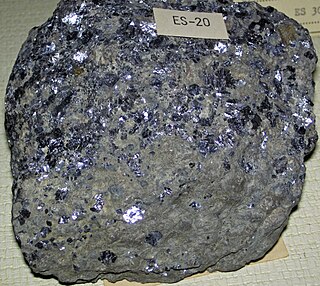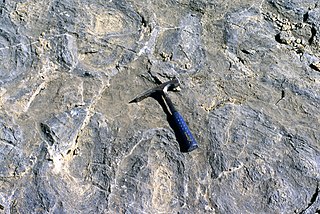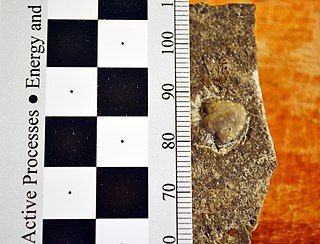 W
WThe Bonneterre Formation is an Upper Cambrian geologic formation which outcrops in the St. Francois Mountains of the Missouri Ozarks. The Bonneterre is a major host rock for the lead ores of the Missouri Lead Belt.
 W
WThe Campito Formation is a geologic formation in Nevada. It preserves fossils dating back to the Cambrian period.
 W
WThe Carrara Formation is a geologic formation in Nevada. It preserves fossils dating back to the Cambrian period.
 W
WThe Ella Island Formation is a geologic formation in Greenland. It preserves fossils dating back to the Cambrian period.
 W
WThe Gros Ventre Formation is a geologic formation in Wyoming, USA. It preserves fossils dating back to the Cambrian period. The Gros Ventre consists of three main members; the Wolsey Shale, the Death Canyon Limestone, and the Park Shale.
 W
WThe Harpers Formation is a geologic formation in Maryland, Pennsylvania, Virginia, and West Virginia, consisting of schist, phyllite, and shale. It dates back to the early Cambrian period. It is considered part of the Chilhowee Group.
 W
WKrukowski Quarry is a sandstone quarry near Mosinee, Wisconsin. In the late Cambrian period, this area was a beach and shoreline, and the quarry is well known for abundant fossil impressions of Climactichnites, Protichnites, and beached jellyfish, Scyphozoan Medusae. Pre-Devonian evidence of this jellyfish is exceedingly rare; this location and one in New Brunswick hold the only known fossils. The fossilized tracks of Climactichnites and Protichnites are also amongst the best preserved examples in the world. No fossilized remains of the either animal exist, making them enigmatic species. The quality and quantity of these fossil tracks in the quarry are extremely valuable to paleontologists.
 W
WThe Langston Formation is a geologic formation in Idaho and Utah. It preserves fossils dating back to the Cambrian period. The formation is composed of bluish-gray limestone, weathering to a buff color, often with rounded edges.
 W
WThe Latham Shale is a geologic formation in California. It preserves fossils dating back to the Cambrian period.
 W
WMarpolia has been interpreted as a cyanobacterium, but also resembles the modern cladophoran green algae. It is known from the Middle Cambrian Burgess shale and Early Cambrian deposits from the Czech Republic. It comprises a dense mass of entangled, twisted filaments. It may have been free-floating or grown on other objects, although there is no evidence of attachment structures. 40 specimens of Marpolia are known from the Greater Phyllopod bed, where they comprise 0.08% of the community.
 W
WThe Mount Cap Formation is a geologic formation exposed in the Mackenzie Mountains, northern Canada. It was deposited in a shallow shelf setting in the late Early Cambrian, and contains an array of Burgess Shale-type microfossils that have been recovered by acid maceration.
 W
WThe Orr Formation is a geologic formation in Utah. It preserves fossils dating back to the Cambrian period.
 W
WThe Park Shale is a geologic formation in Wyoming. It preserves fossils dating back to the Cambrian period.
 W
WThe Pilgrim Formation is a geologic formation in Montana. It preserves fossils dating back to the Cambrian period.
 W
WThe Snowy Range Formation is a geologic formation in Montana. It preserves fossils dating back to the Cambrian period.
 W
WThe Sparagmite Formation is a geologic formation in Norway. It preserves fossils dating back to the Cambrian period.
 W
WThe Spence Shale is the middle member of the Langston Formation in southeastern Idaho and northeastern Utah. It is exposed in the Bear River Range, the Wasatch Range and the Wellsville Mountains. It is known for its abundant Cambrian trilobites and the preservation of Burgess Shale-type fossils.
 W
WThe Whipple Cave Formation is a geologic formation in Nevada. It preserves fossils dating back to the Cambrian period.
 W
WThe Wolsey Shale is a geologic formation in Montana. It preserves fossils dating back to the Cambrian period.